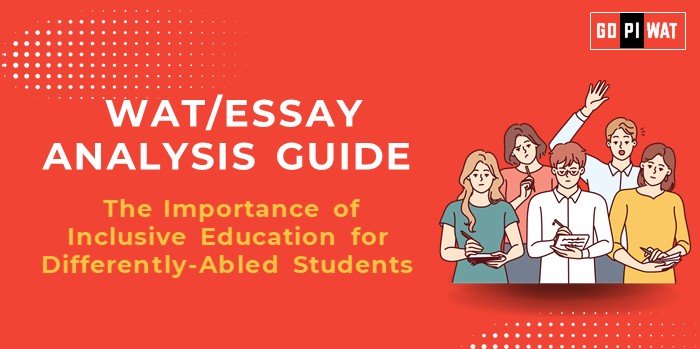📋 WAT/Essay Analysis Guide: The Importance of Inclusive Education for Differently-Abled Students
🌟 Understanding Inclusive Education’s Importance
Inclusive education integrates differently-abled students into mainstream classrooms, promoting equity, social acceptance, and equal opportunities. It aligns with societal goals of creating an inclusive environment while contributing to economic and personal empowerment.
🕑 Effective Planning and Writing
- 📝 Time Allocation:
- Planning: 5 minutes
- Writing: 20 minutes
- Review: 5 minutes
- 💡 Preparation Tips:
- Gather data on inclusive education policies and their outcomes.
- Understand international benchmarks like the IDEA Act (US) and Finland’s inclusive education model.
- Highlight achievements and challenges within India’s education system.
✍️ Introduction Techniques for Essays
- ⚖️ Contrast Approach: “While developed nations achieve near-total inclusivity in schools, 40% of Indian children with disabilities remain out of education.”
- 🔧 Solution-Based Approach: “Inclusive education transforms lives by breaking barriers of inequality. Implementing this model is essential to ensure that no child is left behind.”
🏆 Structuring the Essay Body
✅ Achievements
- 📜 Policy Frameworks: Initiatives like NEP 2020 emphasize the importance of inclusive education.
- 💻 Assistive Technologies: Tools like speech-to-text software and accessible learning materials have improved educational access.
- 🏫 Case Studies: Kerala’s schools using digital tools have successfully mainstreamed differently-abled students into classrooms.
⚠️ Challenges with Comparative Analysis
- 🏚️ Resource Shortages: Insufficient funding, trained teachers, and accessible infrastructure hinder implementation.
- 🔍 Social Stigma: Persistent biases limit inclusive opportunities, particularly in rural and underdeveloped regions.
- 🌍 Comparative Global Insights:
- 🇫🇮 Finland: A robust support system integrates students with special needs seamlessly into regular schools.
- 🇺🇸 US IDEA Act: Legislation mandates inclusive education, providing financial and structural support for differently-abled learners.
🚀 Future Outlook
- 💡 Technology Integration: Innovations like AI-powered learning tools and digital classrooms can make education more accessible.
- 📈 Policy Enhancements: Expanding funding and implementing NEP 2020 can drive inclusive education reforms.
- 🤝 Collaboration: Promoting public-private partnerships will provide necessary infrastructure and assistive technology.
🔚 Concluding Effectively
- ⚖️ Balanced Perspective: “Inclusive education holds immense potential to bridge gaps and empower every learner. However, sustained investment in training, infrastructure, and awareness is critical for long-term success.”
- 🌍 Global Comparison: “With policies like the IDEA Act in the US and Finland’s inclusive education model, India can strive to create an equitable educational landscape tailored to its unique challenges.”
📊 Analyzing Successes and Shortcomings
- ✅ Key Achievements:
- Assistive technologies enhance accessibility.
- Progressive policies like NEP 2020 provide a roadmap for inclusivity.
- Increased awareness reduces stigma gradually.
- ⚠️ Ongoing Challenges:
- Unequal infrastructure access in rural areas.
- Shortage of trained teachers specializing in inclusive teaching methodologies.
- Social and cultural biases continue to marginalize differently-abled students.
- 🌎 Global Context:
- Finland and the US serve as benchmarks, offering strategies for policy-driven reforms and technological advancements.
🚀 Recommendations for Sustainable Progress
- 💰 Budget Allocations: Increase funding for infrastructure and inclusive education materials.
- 👩🏫 Teacher Training: Develop nationwide training programs for educators on inclusive teaching methods.
- 🔗 Public-Private Partnerships: Collaborate with tech companies to develop affordable assistive technologies.
- 🗣️ Awareness Campaigns: Run campaigns to address social stigma and promote an inclusive mindset.
✍️ Sample Short Essays
⚖️ Balanced Perspective
“Inclusive education is a moral and social imperative that empowers differently-abled students. While policies like NEP 2020 provide hope, sustained efforts in funding, infrastructure, and teacher training will determine its success.”
🔧 Solution-Oriented
“Mandatory investments in teacher training, assistive technologies, and awareness campaigns can make inclusive education a reality in India, ensuring no child is left behind.”
🌍 Global Comparison
“Countries like Finland and the US showcase successful inclusive education models. India must localize such strategies, ensuring equitable opportunities for differently-abled students.”


